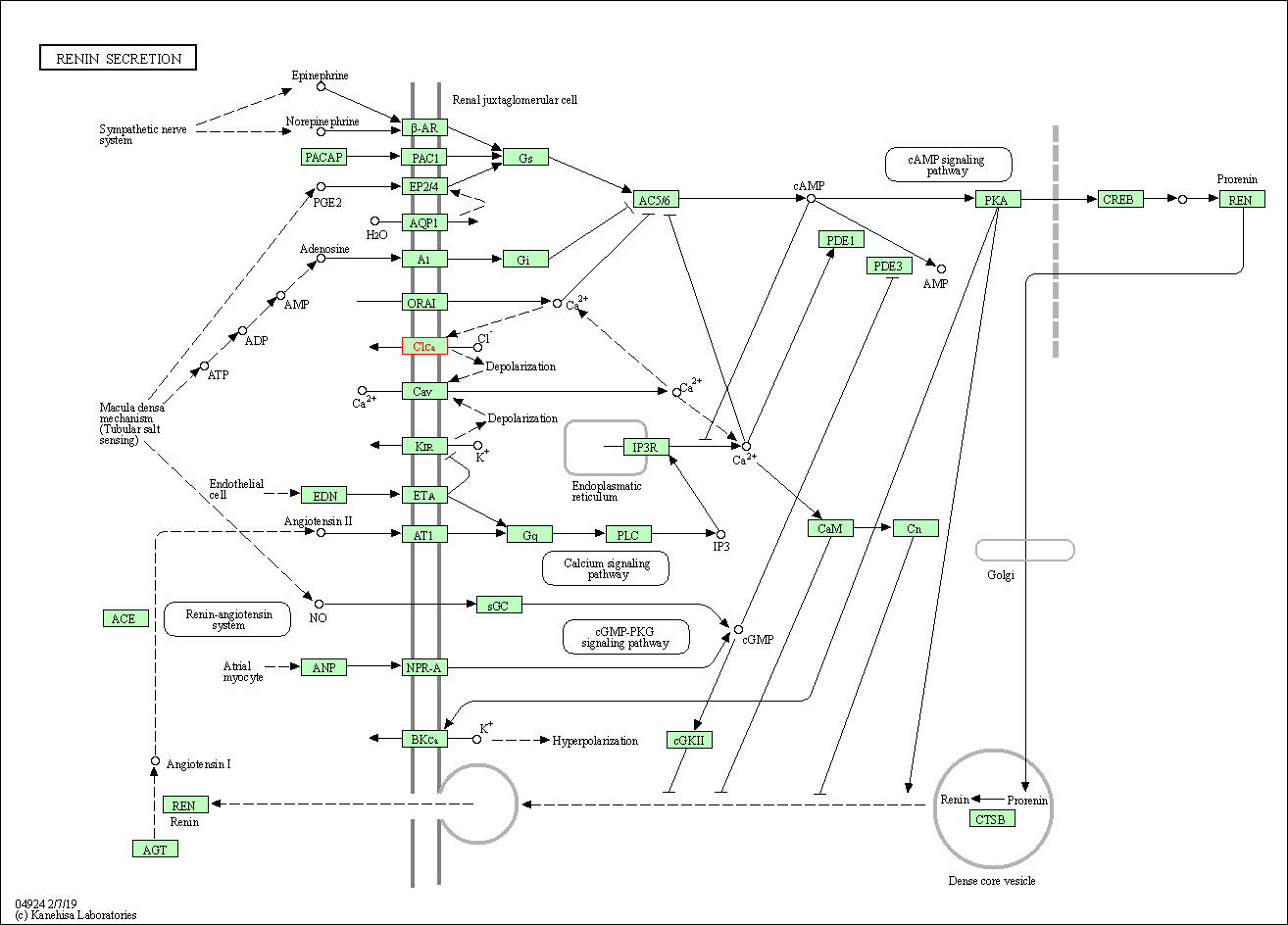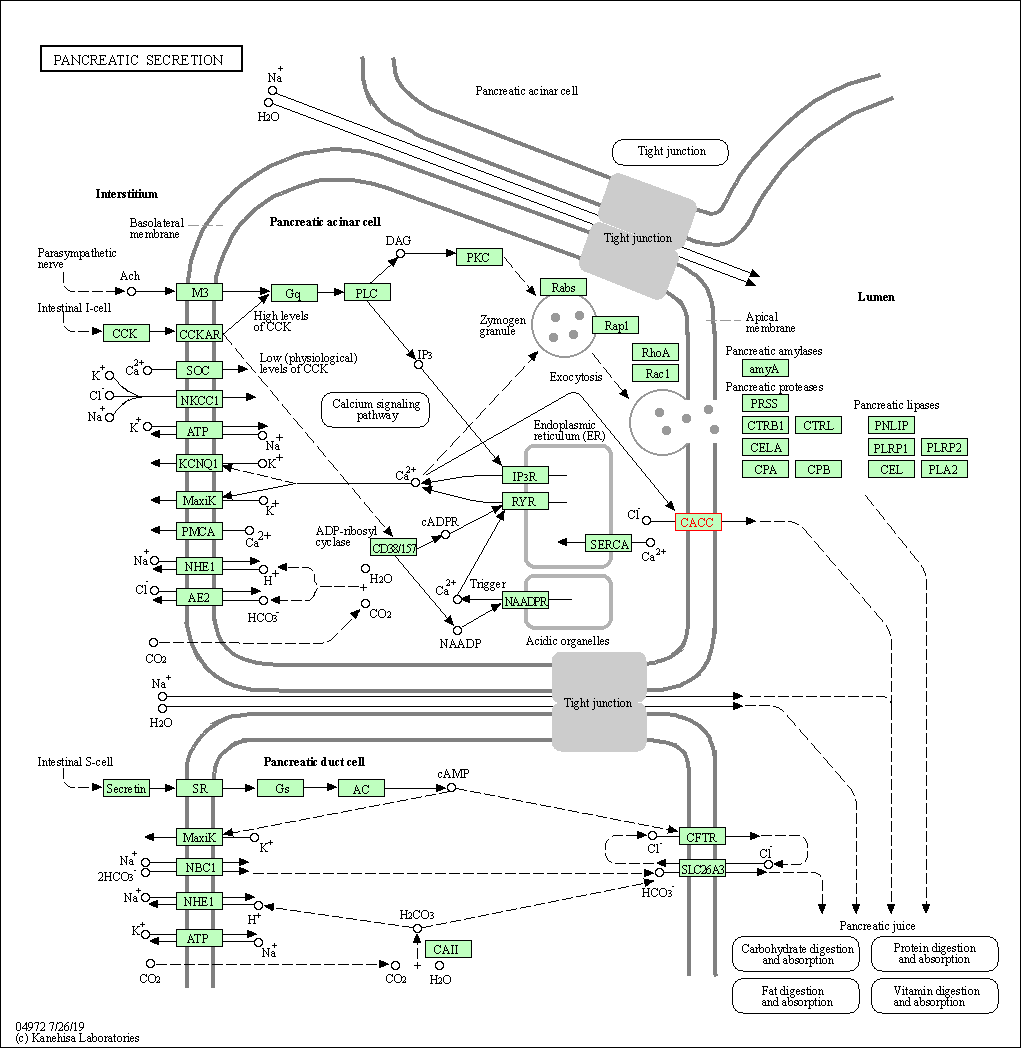Target Information
| Target General Information | Top | |||||
|---|---|---|---|---|---|---|
| Target ID |
T47995
(Former ID: TTDR00495)
|
|||||
| Target Name |
Calcium-activated chloride channel protein 1 (CaCC-1)
|
|||||
| Synonyms |
hCaCC-1; hCLCA1; Calcium-activated chloride channel regulator 1; Calcium-activated chloride channel family member 1; CaCC-1; CACC1
Click to Show/Hide
|
|||||
| Gene Name |
CLCA1
|
|||||
| Target Type |
Literature-reported target
|
[1] | ||||
| Function |
May be involved in mediating calcium-activated chloride conductance. May play critical roles in goblet cell metaplasia, mucus hypersecretion, cystic fibrosis and AHR. May be involved in the regulation of mucus production and/or secretion by goblet cells. Involved in the regulation of tissue inflammation in the innate immune response. May play a role as a tumor suppressor. Induces MUC5AC.
Click to Show/Hide
|
|||||
| BioChemical Class |
Voltage-gated ion channel
|
|||||
| UniProt ID | ||||||
| EC Number |
EC 3.4.-.-
|
|||||
| Sequence |
MGPFKSSVFILILHLLEGALSNSLIQLNNNGYEGIVVAIDPNVPEDETLIQQIKDMVTQA
SLYLLEATGKRFYFKNVAILIPETWKTKADYVRPKLETYKNADVLVAESTPPGNDEPYTE QMGNCGEKGERIHLTPDFIAGKKLAEYGPQGRAFVHEWAHLRWGVFDEYNNDEKFYLSNG RIQAVRCSAGITGTNVVKKCQGGSCYTKRCTFNKVTGLYEKGCEFVLQSRQTEKASIMFA QHVDSIVEFCTEQNHNKEAPNKQNQKCNLRSTWEVIRDSEDFKKTTPMTTQPPNPTFSLL QIGQRIVCLVLDKSGSMATGNRLNRLNQAGQLFLLQTVELGSWVGMVTFDSAAHVQNELI QINSGSDRDTLAKRLPAAASGGTSICSGLRSAFTVIRKKYPTDGSEIVLLTDGEDNTISG CFNEVKQSGAIIHTVALGPSAAQELEELSKMTGGLQTYASDQVQNNGLIDAFGALSSGNG AVSQRSIQLESKGLTLQNSQWMNGTVIVDSTVGKDTLFLITWTMQPPQILLWDPSGQKQG GFVVDKNTKMAYLQIPGIAKVGTWKYSLQASSQTLTLTVTSRASNATLPPITVTSKTNKD TSKFPSPLVVYANIRQGASPILRASVTALIESVNGKTVTLELLDNGAGADATKDDGVYSR YFTTYDTNGRYSVKVRALGGVNAARRRVIPQQSGALYIPGWIENDEIQWNPPRPEINKDD VQHKQVCFSRTSSGGSFVASDVPNAPIPDLFPPGQITDLKAEIHGGSLINLTWTAPGDDY DHGTAHKYIIRISTSILDLRDKFNESLQVNTTALIPKEANSEEVFLFKPENITFENGTDL FIAIQAVDKVDLKSEISNIARVSLFIPPQTPPETPSPDETSAPCPNIHINSTIPGIHILK IMWKWIGELQLSIA Click to Show/Hide
|
|||||
| 3D Structure | Click to Show 3D Structure of This Target | AlphaFold | ||||
| Cell-based Target Expression Variations | Top | |||||
|---|---|---|---|---|---|---|
| Cell-based Target Expression Variations | ||||||
| Different Human System Profiles of Target | Top |
|---|---|
|
Human Similarity Proteins
of target is determined by comparing the sequence similarity of all human proteins with the target based on BLAST. The similarity proteins for a target are defined as the proteins with E-value < 0.005 and outside the protein families of the target.
A target that has fewer human similarity proteins outside its family is commonly regarded to possess a greater capacity to avoid undesired interactions and thus increase the possibility of finding successful drugs
(Brief Bioinform, 21: 649-662, 2020).
Human Tissue Distribution
of target is determined from a proteomics study that quantified more than 12,000 genes across 32 normal human tissues. Tissue Specificity (TS) score was used to define the enrichment of target across tissues.
The distribution of targets among different tissues or organs need to be taken into consideration when assessing the target druggability, as it is generally accepted that the wider the target distribution, the greater the concern over potential adverse effects
(Nat Rev Drug Discov, 20: 64-81, 2021).
Human Pathway Affiliation
of target is determined by the life-essential pathways provided on KEGG database. The target-affiliated pathways were defined based on the following two criteria (a) the pathways of the studied target should be life-essential for both healthy individuals and patients, and (b) the studied target should occupy an upstream position in the pathways and therefore had the ability to regulate biological function.
Targets involved in a fewer pathways have greater likelihood to be successfully developed, while those associated with more human pathways increase the chance of undesirable interferences with other human processes
(Pharmacol Rev, 58: 259-279, 2006).
Human Similarity Proteins
Human Tissue Distribution
Human Pathway Affiliation
|
|
| Protein Name | Pfam ID | Percentage of Identity (%) | E value |
|---|---|---|---|
| von Willebrand factor A domain-containing protein 3A (VWA3A) | 29.375 (47/160) | 5.49E-04 |
|
Note:
If a protein has TS (tissue specficity) scores at least in one tissue >= 2.5, this protein is called tissue-enriched (including tissue-enriched-but-not-specific and tissue-specific). In the plots, the vertical lines are at thresholds 2.5 and 4.
|
| KEGG Pathway | Pathway ID | Affiliated Target | Pathway Map |
|---|---|---|---|
| Renin secretion | hsa04924 | Affiliated Target |

|
| Class: Organismal Systems => Endocrine system | Pathway Hierarchy | ||
| Pancreatic secretion | hsa04972 | Affiliated Target |

|
| Class: Organismal Systems => Digestive system | Pathway Hierarchy | ||
| References | Top | |||||
|---|---|---|---|---|---|---|
| REF 1 | Association of the hCLCA1 gene with childhood and adult asthma. Genes Immun. 2004 Nov;5(7):540-7. | |||||
If You Find Any Error in Data or Bug in Web Service, Please Kindly Report It to Dr. Zhou and Dr. Zhang.

